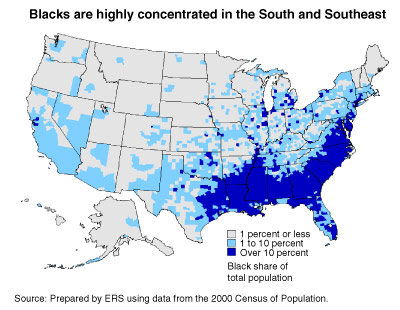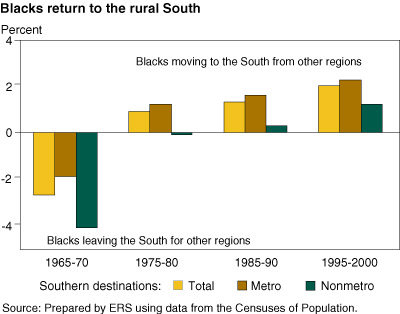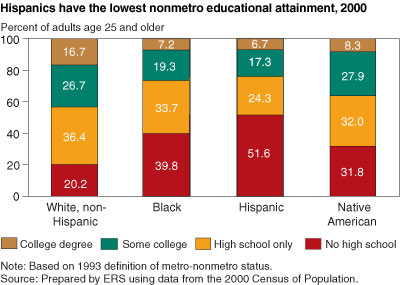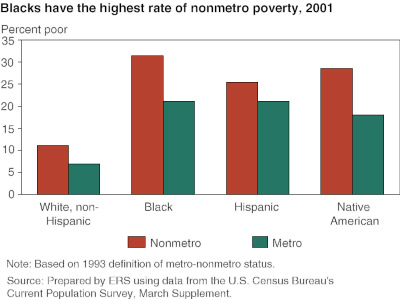Progress and Partnerships in a Dynamic Rural America
- by Leslie Whitener, Joseph Jen and Kathleen Kassel
- 2/1/2004
One hundred years ago, most Americans lived in rural communities. Rural areas served as the major source of food and fiber production for consumption and trade, and the food and fiber system employed the majority of the rural population. A typical rural community in 1900 consisted of a small town or village with numerous small farms nearby (see “The Jesup Wagon”).
Today, rural people and communities are engaged in a wide range of economic activities—from manufacturing to mining, from recreational services to agriculture. Improved communication and transportation infrastructures have narrowed the geographical and cultural differences between rural and urban communities. As these changes unfolded in the 20th century, rural America housed a smaller share of the Nation’s population. About 17 percent of the population—over 49 million people—now live in over 2,000 nonmetropolitan (nonmetro) counties throughout the United States, based on the 2003 definition of nonmetro areas.
Current demographic and economic trends will help shape the future of rural America, its communities, and its residents. Changing migration patterns, increased educational attainment, and industrial restructuring have important implications for rural residents, particularly the almost 4.1 million African-Americans, or Blacks (the largest minority group in rural areas), who reside in small towns and rural areas of the United States (see “February is Black History Month”).
Blacks are geographically concentrated in the South, with nearly three-fourths of rural Blacks living in the South Atlantic and East South Central regions. Rural counties with high concentrations of African-Americans are frequently characterized by a greater degree of economic disadvantage than other rural counties, as evidenced by high levels of poverty and unemployment and low levels of income and earnings. A wide variety of economic development strategies call for unique partnerships among public and private institutions and promise to enhance economic opportunities for Blacks and other rural residents in a changing rural America.
Changing Demographics Create New Needs
The rural population grew by over 10 percent during the 1990s, up from 3 percent in the previous decade. In many areas of the West, the southern Appalachians, and the upper Great Lakes, moderate climates, scenic features, and other natural amenities stimulated rapid population growth. In the rural South, high population growth resulted largely from urban sprawl, especially around large urban areas, such as Atlanta. In contrast, the majority of counties in the Great Plains and western Corn Belt continued to lose population in the 1990s as they wrestled with declining farm employment and the lack of replacement jobs in other industries.
A particularly dramatic population change in the last three decades is the return migration of African-Americans to the South, reversing a longstanding trend of African-American migration loss from the region. After a net loss of almost 300,000 African-Americans in the last half of the 1960s, the net inmigration of Blacks to the South has become more pronounced in each 5-year period up to the present. Newly released Census data show that between 1995 and 2000, the South saw a strong return of Blacks to the region—nearly 350,000—and, in particular, an unprecedented turnaround in Blacks moving to the rural South.
These migration patterns are tied to economic development, as the South has grown in industrialization and income. As earnings prospects improved, fewer people left the region. For the same reasons, the South has become more attractive to residents of other regions. Family ties also factor into Black return migration to the rural South, as increasing numbers of African-Americans return to their place of birth along with their children and spouses.
These changing population patterns create both positive and negative impacts. In some rural areas, new settlement patterns are contributing to the revitalization of small towns that have seen their populations dwindle over the years. In other areas, rapid growth is straining community resources, as local areas strive to provide essential services, programs, and infrastructure to both native populations and new residents.
Industrial Restructuring Presents New Opportunities
Farming continues to be an important component of the rural economy, but it no longer anchors most rural communities as it did through the mid-20th century. In 1969, 935 rural counties depended on farming for 20 percent or more of their total income. Thirty years later, the number had fallen to 262 counties. Today, manufacturing, retail and wholesale trade, and services contribute heavily to the economy of many rural counties.
In response to long-term declines in mining and agricultural employment, some rural areas have successfully attracted new population and employment based on their natural resources and amenities. ERS’s natural amenities scale measures the climate, lay of the land, water area, and other physical characteristics that enhance a county’s desirability as a place to live. Although the West contains most of the counties classified as very high on the amenity scale, high-amenity counties are also found throughout the South. Many of these areas represent untapped resources for enhancing population and employment growth in rural areas.
Other strategies to address long-term industrial restructuring in rural areas include promoting farm-related businesses, such as food processing and marketing, and generating local farm-related industries that produce input products, such as fertilizer and manufactured feeds. Adoption of a telecommunications infrastructure can provide farmers and others with better access to information, markets, and technical assistance. Also, some areas can capitalize on a more educated population to attract manufacturers to a highly skilled labor force.
Increasing Educational Attainment Opens Doors
Rural Americans have higher levels of education than ever before. In 2000, about one in six rural adults age 25 and older had graduated from a 4-year college, more than double the rate in 1970. The share of rural adults without a high school diploma fell to a historic low of 23 percent in 2000. Rural residents, particularly racial and ethnic minorities, have lower educational levels than urban residents. Rural Blacks were only half as likely to hold a college degree as urban Blacks—the largest educational attainment difference among races. Still, educational levels among rural African-Americans increased sharply in recent decades, including their high school completion rate, which rose 12 percentage points between 1990 and 2000.
Higher educational levels, specifically a college degree, have resulted in increased labor market rewards to rural residents in the past 20 years. Rural college graduates now earn more than twice as much as rural high school dropouts and have far lower unemployment rates. However, college graduates still earn much more in urban areas than in rural areas. Metro college graduates earned 12 percent more than nonmetro college graduates in 2002. This wage differential encourages better educated rural youth to move to urban areas, making it harder for rural counties to build and keep their human capital base.
Despite improvements, low educational levels still pose a challenge for many rural counties seeking economic development. High school dropout rates continue to be high in rural areas throughout the South and Southwest, including many central Appalachian counties and counties with large minority populations. Raising educational levels—and the quality of education—is essential to improving the economic life of rural communities and the well-being of the rural population.
Rural Diversity Leads to Different Needs
Variation in rural needs means that the most successful economic development strategies will be multifaceted. The 1990s was a decade of unprecedented U.S. prosperity, ending with record-high average income levels and the lowest unemployment rate in 30 years. As a result, the incidence of poverty dropped from a decade earlier, particularly in rural areas, where the poverty rate fell from 17 to 14 percent (see “Nonmetro Poverty: Assessing the Effect of the 1990s” in Amber Waves, September 2003). The poverty level of rural African-Americans also declined in the 1990s, but with a poverty rate of 31 percent, Blacks continued to have the highest poverty of any rural racial/ethnic group.
Despite the overall improvement in poverty status, over 400 nonmetro counties still had high poverty rates of 20 percent or more in 2000, well above the rural average. Over half of these counties were classified as Black high-poverty counties, reflecting the low incomes of their African-American residents (see “Anatomy of Nonmetro High-Poverty Areas: Common in Plight, Distinctive in Nature” elsewhere in this issue). These rural counties lie in the old plantation belt of the southern coastal plain, especially from southern North Carolina through Louisiana, and many have consistently had poverty rates of 20 percent or more for the last 40 years.
Rural development strategies are often more difficult to implement in consistently high poverty areas because of inherent structural and human capital disadvantages. Such counties have a disproportionate share of economically at-risk residents, including single mothers and high school dropouts. At the same time, the local economies of these areas are generally weaker than economies in other rural places. In persistently poor counties, population growth and employment growth are below that of rural areas as a whole, unemployment and poverty are higher, and earnings and income are lower.
The diverse needs of rural America will require a diverse approach to economic development. According to recent ERS research on welfare reform in rural areas, the poorest and most remote areas are often the hardest to serve (see “Rural Welfare Reform: Lessons Learned” in Amber Waves, June 2003). Strategies to improve the economic well-being of rural residents will be most successful when tailored to individual and community needs.
Partnerships for the Future
Rural America faces many opportunities and challenges in the 21st century. Efforts to seize these opportunities and surmount the challenges of the “new rural economy” call for unique partnerships among a wide range of institutions concerned with a changing rural America. An example of a successful local, State, and Federal partnership is the one linking USDA, the 1890 institutions, and Tuskegee University in efforts to enhance the economic opportunities and quality of life for rural people. In 1890, Congress expanded the original system of land-grant universities to include historically Black institutions. In partnership with USDA, these 18 institutions in the South have developed teaching, research, and extension programs to serve rural communities, assist limited-resource farm operators, and enhance the economic opportunities for all rural residents (see “The Land-Grant System”).
USDA’s Cooperative State Research, Education, and Extension Service (CSREES) administers a portfolio of programs in partnership with the 1890 institutions and Tuskegee University to enhance education, build research capabilities, and develop outreach initiatives in underserved communities:
- The 1890 Institution Capacity Building Grants Program is designed to strengthen partnerships, promote workforce diversity, and enhance the 1890 institutions’ teaching and research programs in the food and agricultural sciences. The program’s primary goal is to recruit and train outstanding students from groups traditionally underrepresented in scientific and professional careers in the U.S. food and fiber sector.
- The Evans-Allen Program provides annual funding to support continuing agricultural research at the 1890 institutions. With the help of this program, the 1890 institutions are generating new knowledge to promote small farms, sustainable agriculture, rural economic development, human nutrition, and rural health.
- The 1890 Institution Extension Program supports their efforts to foster, develop, implement, and improve extension and outreach programs for their clientele.
- The Outreach and Technical Assistance for Socially Disadvantaged Farmers Program provides assistance to help minority and disadvantaged farmers to own and operate farms and to participate in agricultural programs.
USDA also supports a variety of agricultural and rural development research grants, contracts, and agreements with 1890 institutions and Tuskegee University. For example, CSREES provides research funds to support a range of studies:
- Assessing Programs and Policies for Sustainable Rural Development with Tuskegee University
- Food Safety Education for Underserved Communities with Alabama A&M University
- Survival Strategies Among Minority Farm Operators with North Carolina A&T State University
- The Efficacy of Services for the Rural Elderly in North Florida with Florida A&M University
- Impact of Business Climate on Employment Growth with South Carolina State University
ERS and four 1890 institutions—Delaware State University, South Carolina State University, Tuskegee University, and Virginia State University—recently joined forces to study the economic benefits of 1890 institutions. The joint project assessed the outcomes and benefits of investments in the 1890 institutions’ food and agricultural science programs and developed a conceptual model to better quantify and improve the effectiveness of investments in the 1890’s programs and initiatives.
Partnerships, such as the one between USDA and the 1890 institutions, can promote, develop, and maintain a scientific and analytical information system to better address the challenges facing rural America. Today’s rural communities face different circumstances than those in 1900, and rural needs assessment, program development, and policy evaluation across the Federal Government can benefit from such a scientific information system. The continued success of these efforts will depend on sharing ideas, embracing contributions of all interested parties, and focusing on a common goal—to enhance rural economic opportunities.
This article is drawn from:
- Rural Economy & Population. (n.d.). U.S. Department of Agriculture, Economic Research Service.
- Hamrick, K. (2003). Rural America at a Glance (2003). U.S. Department of Agriculture, Economic Research Service. RDRR-97-1.
- Gibbs, R. (2004). Rural Education at a Glance. U.S. Department of Agriculture, Economic Research Service. RDRR-98.
- Fuguitt, G.V., Fulton, J. & Beale, C.L. (2001). The Shifting Pattern of Black Migration From and Into the Nonmetropolitan South, 1965-95. U.S. Department of Agriculture, Economic Research Service. RDRR-93.
- Progress and Partnerships in a Changing Rural America. (2003). Professional Agricultural Workers Conference, Tuskegee, AL.





